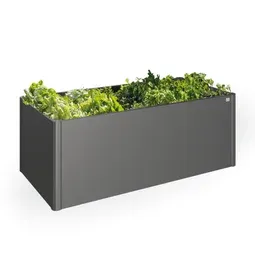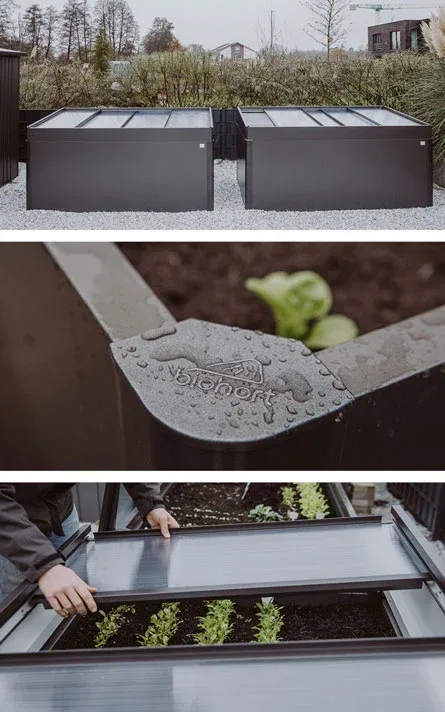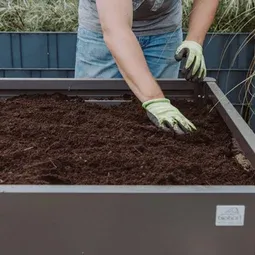Raised beds in winter -
Tips for growing winter vegetables

Fresh vegetables on the plate in winter? Yes, it's possible! Winter vegetables are hardy, rich in vitamins, and full of flavour, bringing freshness and variety to the kitchen even during the cold season. It doesn't matter whether you have a large or small garden, or just a balcony, because growing winter vegetables is possible anywhere. Especially in raised beds, vegetables like kohlrabi, lamb's lettuce, leeks, and more thrive excellently. This blog post will explain how to successfully grow winter vegetables in a raised bed and what to keep in mind. With these tips, you can enjoy crisp, homegrown vegetables even in sub-zero temperatures.
Gardening happiness in winter - raised beds make it possible
a. Ecological, health and economic benefitsPrerequisites for growing vegetables in a raised bed
a. Choice of location
b. Filling the raised bedGrowing winter vegetables in a raised bed - how it works
a. Choosing the variety: Which vegetables thrive best in winter
b. Sowing and care: When should winter vegetables be planted in the raised bed?
Gardening bliss in winter - raised beds make it possible
The cold winter months don't necessarily mean a break for gardening enthusiasts. A welcome change from the usual winter vegetables found in supermarkets is definitely possible. Homegrown winter vegetables from your own raised bed are not only tasty and rich in vitamins, but they also offer several advantages.
Ecological, health and economic benefits
Short distances from harvest to consumption mean fewer CO2 emissions and reduce the problem of over-packaging supermarket products, which is good for the environment and a more sustainable lifestyle.
In addition, home-grown winter vegetables are high in nutrients and vitamins. Eating freshly harvested vegetables ensures a supply of important nutrients and strengthens the immune system. As a result, we are better able to withstand the typical winter illnesses.
Some of the most significant cost savings come from the fact that fresh vegetables, especially organic products in the supermarket, are often expensive. A significant proportion of these costs are for packaging, transport and possibly pesticides and other chemical treatments. Growing your own, on the other hand, is more cost-efficient.
Requirements for growing vegetables in a raised bed
A raised bed is suitable for gardens, terraces or balconies and can be positioned flexibly according to requirements. So if you don't have a garden, you don't have to do without fresh winter vegetables.
The long-lasting planting beds from Biohort are ideal for the balcony. They are easy to set up and maintain and offer enough space and the right conditions to successfully grow winter vegetables on the balcony.
Tips and tricks for efficient gardening in the smallest of spaces can be found in our blog post.
Choice of location
There are several aspects to consider when placing a raised bed to ensure optimal conditions for the plants to survive during the winter.
Sun: Ideally, the location should be chosen so that the plants receive plenty of sunlight. In winter, the days are shorter and the sun is lower, so it is important to choose a location that receives the most sunlight during the day.
Protection from wind and cold: The raised bed should be placed in a sheltered position to protect it from strong winds and extremely cold temperatures. A position against a house or garage wall can help to provide wind protection and retain a little more heat.
Access: Ideally, the raised bed should be positioned so that you don't have to wade through the snow or slip on slippery surfaces.
The extremely durable raised bed from Biohort is a first-class choice for growing plants in winter and comes with a variety of benefits.
One helpful feature is the integrated rodent protection made of fibreglass mesh, which protects the plants from potential pests.
Biohort offers a matching cold frame extension for the raised bed size 2x1. The four sliding double-webbed panels allow easy access and have a slightly insulating property that can cause the interior to heat up during the day due to the greenhouse effect. These panels can also be easily removed.
The combination of all these features makes the Biohort raised bed an extremely practical and useful choice for horticulture, even during the winter months. It enables the healthy cultivation of plants under optimal conditions and is designed to be extremely easy to maintain and user-friendly.
Buying a raised bed - 5 things to consider when buying
A raised bed is an excellent way to grow your own vegetables and herbs. It offers many advantages, such as an ergonomic way of working and better control over the soil and plants... read more.
Filling the raised bed
A mix of different layers is crucial for a fertile raised bed. At the bottom is a coarse layer of branches and twigs, followed by leaves and grass cuttings. The next layers consist of compost and garden soil.
Biohort tip: Take the opportunity now to add the last of your grass and shrub cuttings to the raised bed. The material can decompose well over the winter so that the soil can be added next year.
More on filling the raised bed in our blog post.
Growing winter vegetables in raised beds - how it works
Gardening in winter? What sounds like a contradiction at first was a matter of course for our ancestors. Certain types of vegetables defy frost and snow and continue to provide fresh vegetables throughout the winter months.
Choice of variety: Which vegetables thrive best in winter?
Whether in the garden or on the balcony, choosing the right vegetables is crucial for successful cultivation. Many vegetables actually have summer and winter varieties, so the hardy varieties should always be chosen. Information on whether seeds are hardy can usually be found on the packaging or in the product description. Manufacturers often provide information on suitable sowing times and care requirements.
Vegetable varieties that thrive particularly well in winter include kohlrabi, kale, leeks, lettuce and carrots. But radishes,arugula and spinach are not only known for their culinary benefits, but are also a favourite winter vegetable. Not only are they robust, but they are also particularly rich in valuable nutrients.
The above varieties are presented below along with a brief description.
Kohlrabi is a robust and cold-tolerant vegetable that can be grown in winter. It is particularly suitable for growing in raised beds as it does not require a large area of soil. The ideal location is sunny to semi-shady and the soil should be rich in nutrients. Kohlrabi can even withstand mild frost, but should be protected with fleece or straw in extreme temperatures.
Carrots are also insensitive to the cold and can be harvested well into the winter months as they are not affected by frost. They prefer loose, sandy soil in a sunny location. Care should be taken to ensure that the soil is always slightly moist, but not too wet. Waterlogging or excessively hard soil can impair the growth of carrots.
Many of the common pests and diseases that affect radishes are less present in the colder months. This means that the plants are often healthier and can thrive better. Radishes prefer cool temperatures. Weather that is too warm can cause the plant to grow too quickly and produce leaves instead of tubers. They can survive light frost and continue to grow when temperatures rise again. Some varieties can even withstand severe frost.
Arugula is a cold-resistant leafy vegetable that can tolerate cool temperatures to a certain degree. In fact, arugula can be grown and harvested throughout the winter in many cool climate zones. Arugula can actually benefit from cooler weather as this can improve the flavour of the vegetable. Cold can increase the production of natural sugars in the leaves, resulting in a sweeter, fuller flavour. As with radishes, there are fewer pests in winter, which reduces the risk of damage to the plants.
Spinach is a real classic among winter vegetables. Spinach can survive in very cold temperatures, even in temperatures that fall well below freezing. A light frost can actually improve the flavour of spinach by enhancing the sweet flavours. Spinach prefers short days and cool temperatures. In fact, too much heat and light can cause the plant to flower too early, which is known as "bolting". In winter, spinach doesn't have this pressure and can grow at a more moderate pace.

Sowing and care: when should winter vegetables be sown in the raised bed?
It is generally recommended to sow winter vegetable varieties early in late summer or early autumn, as they will have already gathered sufficient strength for the cold season. Lamb's lettuce, for example, can be sown as early as August. Winter kohlrabi and winter cabbage can be planted by mid-September, while winter leeks are better sown in spring and then harvested in winter.
7 questions and answers about sowing
When growing vegetables in winter, it is important that the soil does not dry out. Therefore, sufficient watering should be provided even at sub-zero temperatures.
Mulching is another tip to optimise plant care. Mulching involves applying a layer of organic material such as compost, leaves or straw to the surface of the soil. This layer helps to retain moisture in the soil by reducing evaporation. It also acts as an insulating layer and protects the soil from frost. In addition, the organic material helps to improve the soil quality over time as it decomposes and releases nutrients. Even in sub-zero temperatures, plants should therefore be sufficiently watered and mulched to prevent the soil from drying out.
In the event of heavy frost, plants can be covered with fleece or plastic sheeting to protect them. It is important to remove the cover during the day to allow light and air circulation.
After successful care and protection, the vegetables are ready to be harvested. Many winter vegetables, including the above-mentioned kale, only develop their full flavour through frost. So don't be afraid of sub-zero temperatures, as they provide an additional flavour boost.
Gardening in winter may seem unusual at first. However, with the right approach and a little diligence, an amazing variety of vegetables can be cultivated even in the cold season. With a raised bed from Biohort, cultivating winter vegetables is also a lot of fun. Have fun trying out and enjoying the flavour of freshly harvested vegetables - even in the winter months!



